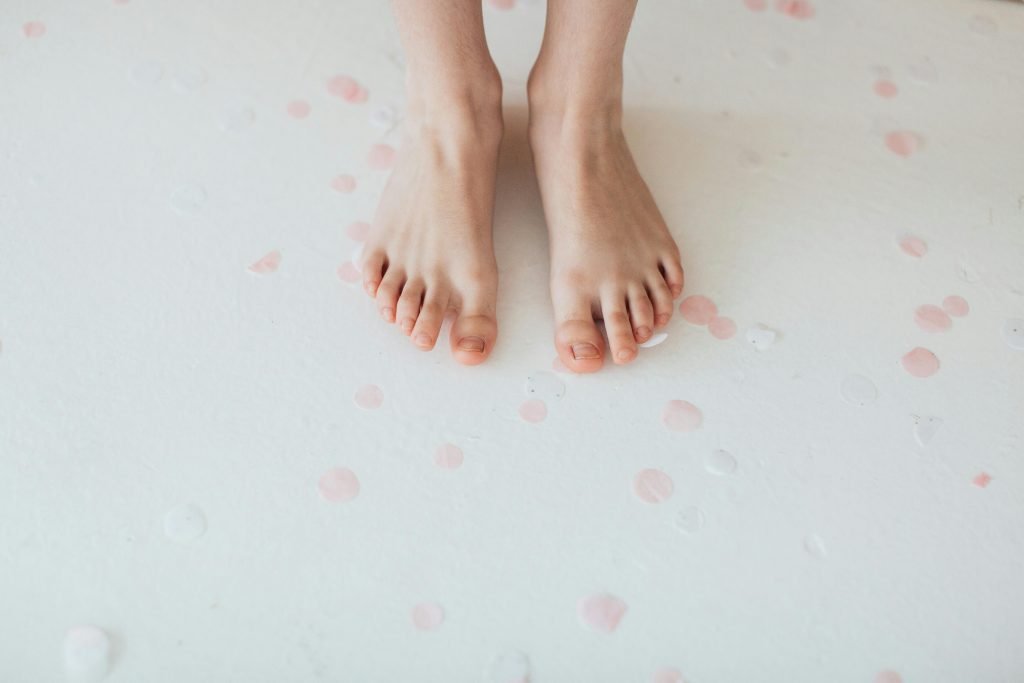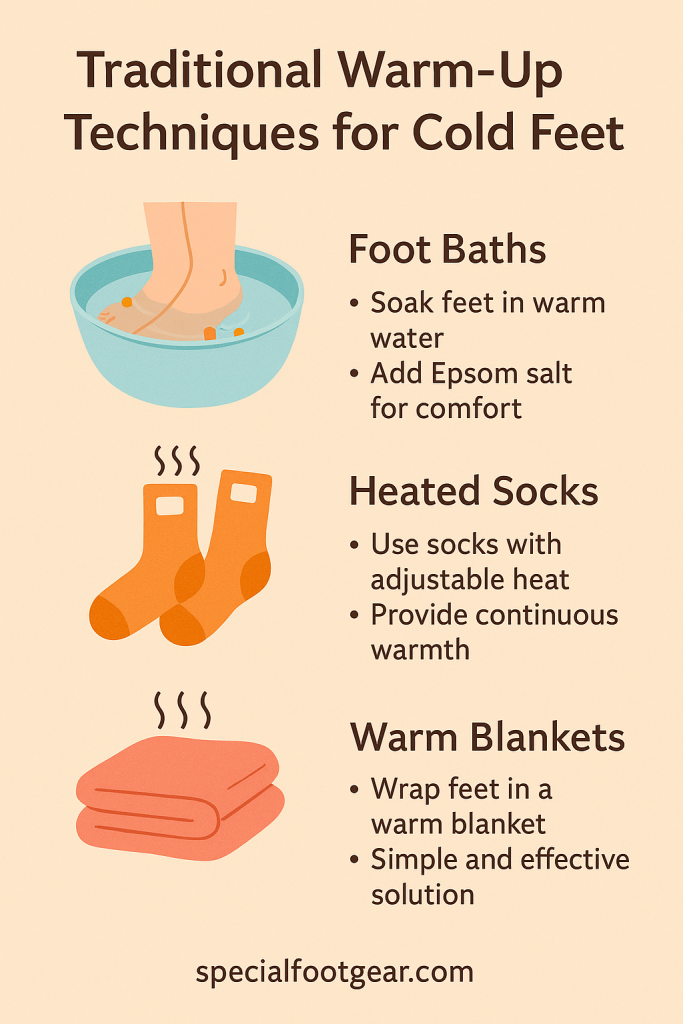To warm up cold feet from neuropathy, try soaking them in warm water or using heated socks. Gentle foot massages also help improve circulation.
Cold feet can be a common issue for individuals with neuropathy. This condition affects nerve function, leading to sensations of numbness and coldness in the extremities. Poor circulation often exacerbates the problem. Warming your feet not only enhances comfort but also promotes better blood flow.
Simple methods can make a significant difference in managing symptoms. From warm baths to heating pads, various techniques exist to alleviate discomfort.
Understanding how to effectively warm your feet can lead to improved overall well-being. This guide explores practical solutions to help you combat cold feet associated with neuropathy.
Cold Feet And Neuropathy: An Introduction
Cold feet can be a common problem for those with neuropathy. Symptoms include numbness, tingling, and pain. Causes often involve nerve damage from conditions like diabetes or peripheral artery disease. Poor blood circulation can also contribute to cold feet.
This condition can greatly impact daily life. Walking may become difficult due to discomfort. Wearing shoes can feel uncomfortable, leading to reduced activity levels. People may avoid social situations, feeling self-conscious about their feet.
Finding ways to warm up cold feet is essential. Simple methods include using warm socks or heating pads. Regular foot massages can improve blood flow. Staying active helps maintain circulation and reduce symptoms.

What Is Cold Feet a Sign Of?
Cold feet aren’t always just a reaction to cold temperatures. In many cases, persistent coldness in the feet can be an early warning sign of deeper health concerns that should not be ignored. Here’s what cold feet might indicate:
- Poor Circulation: When blood isn’t flowing efficiently to your extremities, your feet can feel colder than the rest of your body. Conditions like peripheral artery disease (PAD) often cause reduced circulation.
- Nerve Damage (Neuropathy): Especially common among individuals with diabetes, neuropathy damages the nerves responsible for sensing temperature, leading to persistent cold sensations even in normal environments.
- Anemia: A shortage of healthy red blood cells means less oxygen is delivered throughout the body, including the feet, making them feel icy cold.
- Thyroid Disorders: An underactive thyroid (hypothyroidism) can slow down your metabolism, decreasing heat production and leaving your feet—and sometimes your hands—feeling cold.
- Lifestyle Factors: Habits like smoking or sitting for long periods can impair circulation, compounding cold feet issues over time.

If you find that your feet are frequently cold without an obvious environmental cause, it’s wise to seek medical advice. Early intervention could help prevent complications such as ulcers, infections, or worsening nerve damage.
What Deficiency Causes Cold Feet?
Cold feet are often more than just a response to cold weather—they can signal an underlying deficiency in the body. Several nutritional and mineral shortages may interfere with healthy blood circulation and nerve function, leading to persistent coldness in the feet.

Iron Deficiency (Anemia)
Iron plays a critical role in transporting oxygen through the bloodstream. When iron levels are low, less oxygen reaches the extremities, often resulting in cold, numb, or tingling feet. People with anemia frequently report feeling cold even when others are comfortable.
Signs to watch for:
- Pale skin
- Fatigue
- Shortness of breath
- Cold hands and feet
Vitamin B12 Deficiency
Vitamin B12 is essential for healthy nerve function and the production of red blood cells. A shortage can cause peripheral neuropathy—a condition that often manifests with coldness, tingling, or numbness in the feet and hands.
Common symptoms include:
- Burning sensations in the feet
- Muscle weakness
- Balance problems
- Memory difficulties
Magnesium Deficiency
Magnesium supports muscle and nerve function, including the contraction and relaxation of blood vessels. Low magnesium levels can impair blood circulation, leading to a chilly sensation in the lower extremities.
Additional symptoms may involve:
- Muscle cramps
- Heart palpitations
- Anxiety or irritability
- Fatigue
Thyroid Hormone Deficiency (Hypothyroidism)
While technically a hormonal issue, low thyroid hormone levels can result from iodine or selenium deficiencies. Hypothyroidism slows down the metabolism, making it difficult for the body to maintain a normal temperature, often causing cold feet.
Warning signs might include:
- Unexplained weight gain
- Dry skin
- Depression
- Persistent fatigue
Why Is My Body Warm but My Feet Are Cold?
Feeling warm overall while your feet stay stubbornly cold can be puzzling. This contrast often points toward circulation issues or nerve-related problems. Here are some possible reasons behind this phenomenon:
- Peripheral Artery Disease (PAD): When arteries in your legs and feet become narrowed or clogged, blood can’t reach these areas efficiently, causing cold sensations despite your core feeling warm.
- Nerve Dysfunction: Conditions like diabetic neuropathy damage the nerves responsible for temperature regulation. Even when your blood flow is adequate, the brain might misinterpret signals, making your feet feel colder than they are.
- Raynaud’s Phenomenon: This condition causes small blood vessels in your extremities to constrict excessively, especially in response to cold or emotional stress. As a result, even mild temperatures can trigger freezing feet.
- Prioritized Blood Flow: Your body naturally prioritizes vital organs over extremities. If you’re slightly dehydrated or stressed, your internal systems might direct blood away from your feet.
Understanding these triggers is essential when learning how to manage and improve comfort, especially when searching for how to warm up cold feet from neuropathy in cases linked to nerve damage.
Why Are My Feet Cold With Socks On?
It can be confusing—and frustrating—to find that your feet remain cold even when you’re wearing socks. Here’s why this happens:

- Circulation Problems: If blood flow to your feet is restricted, even the thickest socks won’t help. Improving vascular health is often more critical than just layering up.
- Wrong Type of Socks: Cotton socks, although cozy at first, tend to retain moisture from sweat, which can make your feet colder over time. Wool, bamboo, or specialized moisture-wicking fabrics are far better choices for insulation.
- Compression Issues: Socks that are too tight can actually worsen the problem by cutting off circulation. Always ensure your socks are snug but not constricting.
- Nerve Damage: When neuropathy is involved, no amount of external warmth can fully correct the misfiring nerve signals that create a sensation of coldness. That’s why targeted treatments and proper footwear choices become important.
Being strategic about your sock selection and addressing the root cause of cold feet can significantly enhance your comfort, especially for those exploring how to warm up cold feet from neuropathy effectively.
Importance Of Warming Up Your Feet
Warming up your feet is very important for overall health. Cold feet can cause discomfort and pain. Proper warmth helps improve blood circulation. Good circulation reduces the risk of serious problems.
By warming your feet, you can also reduce neuropathy symptoms. Many people experience less tingling and numbness. This can lead to better mobility and comfort. Simple methods like wearing warm socks or soaking feet help.
| Benefits | Description |
|---|---|
| Improved Circulation | Enhances blood flow to feet and legs. |
| Reduced Pain | Alleviates discomfort from cold temperatures. |
| Increased Mobility | Allows for easier movement and activity. |
| Less Numbness | Minimizes the feeling of tingling in feet. |
Traditional Warm-up Techniques
When struggling with cold feet, especially due to neuropathy or poor circulation, traditional methods can offer immediate relief. These techniques are simple, soothing, and easy to practice at home. Let’s explore how they help and how you can use them effectively:

Foot Baths
One of the oldest and most trusted methods for warming cold feet is a warm foot bath. To do this:
- Fill a basin with comfortably warm water — not hot enough to burn, but warm enough to relax your feet.
- Add Epsom salt if desired. Epsom salt can ease muscle tension and promote better circulation.
- Soak your feet for 15 to 20 minutes, allowing the warmth to penetrate deeply into the muscles and blood vessels.
Foot baths not only warm your feet but also help to relax the entire body. For added comfort, consider adding a few drops of essential oils like lavender or peppermint to the water. After soaking, dry your feet thoroughly to prevent moisture buildup, which can cause further coldness.
Heated Socks
Another effective traditional method is using heated socks. These specially designed socks use battery-operated or electric heating elements to provide continuous warmth throughout the day.
Key benefits of heated socks include:
- Adjustable Temperature Settings: Many modern heated socks allow you to control the heat level, so you can choose the temperature that feels most comfortable.
- Portability: Heated socks are excellent for both indoor relaxation and outdoor activities during colder seasons.
- Targeted Warmth: They focus the heat directly around the toes and soles, areas most vulnerable to cold.
Always choose high-quality heated socks with safety features to avoid overheating or burns.
Warm Blankets
Sometimes the simplest solution is the most effective. Wrapping your feet in a soft, warm blanket can make an immediate difference. Here’s how to make the most out of this method:
- Choose a thick, cozy blanket made of fleece, wool, or thermal material.
- Double-wrap your feet if needed for extra insulation.
- Preheat the blanket slightly near a heater or with a hot water bottle before wrapping for even better results.
Blankets help trap your body heat and provide gentle, passive warming without any complicated devices. They’re especially ideal for relaxing while reading, watching TV, or sleeping.
| Technique | Description |
|---|---|
| Foot Baths | Soak feet in warm water to promote circulation. |
| Heated Socks | Wear temperature-controlled socks for daily warmth. |
| Warm Blankets | Wrap feet snugly to trap and maintain body heat. |
Exercise: A Natural Way To Generate Heat
Exercise is a great way to warm up cold feet caused by neuropathy. Low-impact cardiovascular activities can boost circulation. Try walking, cycling, or swimming. These activities help increase blood flow to the feet.
Foot and ankle exercises are also beneficial. Simple stretches can improve flexibility. Try ankle circles or toe raises. These movements strengthen muscles and enhance blood flow. Aim to do these exercises daily for the best results.
Dietary Considerations For Neuropathy
Eating the right foods can help improve blood flow. Certain nutrients are essential for nerve health. Foods rich in omega-3 fatty acids like salmon and walnuts can be very beneficial. Fruits such as oranges and berries also support circulation.
Spicy foods containing chili peppers can boost blood flow. Garlic is another great option for enhancing circulation. Consuming leafy greens, such as spinach, helps maintain healthy blood vessels.
Staying hydrated is crucial for overall health. Water helps maintain blood volume and circulation. Drinking enough fluids can prevent dehydration and improve nerve function.
Herbal teas, like ginger or peppermint, can also aid in hydration and provide warmth. Aim for at least 8 glasses of water daily to support your body effectively.

Credit: www.atlantamedicalclinic.com
Alternative Therapies
Acupuncture can help improve blood flow to the feet. This technique uses thin needles. It targets specific points on the body to relieve pain. Many people find relief from cold feet after treatment.
Essential oils like peppermint and ginger can warm cold feet. These oils improve circulation and soothe nerves. Aromatherapy uses these scents to create a calming environment. Massaging the oils into your feet can also help.
Try using a diffuser for essential oils. This method spreads the scent throughout the room. Combining acupuncture and aromatherapy can offer great results for neuropathy sufferers.
Medical Interventions
Medications can help relieve neuropathy symptoms. Common options include antidepressants and anti-seizure drugs. These medications help reduce pain and improve nerve function.
Some people benefit from topical treatments. Creams or patches can provide localized relief. Discuss these options with a healthcare provider for the best fit.
Consult a doctor if symptoms worsen or do not improve. Frequent pain, weakness, or numbness may require professional evaluation. Early intervention can prevent further complications.

Credit: www.health.harvard.edu
Daily Habits For Long-term Relief
Maintaining a comfortable temperature at home is essential. Use space heaters or electric blankets to keep your feet warm. Keep doors and windows closed to avoid drafts. Wear socks made from warm materials like wool for extra insulation.
Choosing the right footwear can also help. Look for insulated shoes or slippers that provide warmth. Ensure they fit well to avoid pressure on your feet. Avoid tight shoes, as they can restrict blood flow. Thermal socks can add an extra layer of warmth.
Monitoring And Adapting To Changes
Keeping a symptom diary helps track changes in your feet. Write down when cold feelings occur. Note the temperature and time of day. This can help find patterns in symptoms.
Adjusting strategies becomes easier with this information. If certain activities make your feet colder, change them. Try different warming techniques like socks or foot baths. Always listen to your body and adapt as needed.
Frequently Asked Questions
- How Can I Improve Circulation In My Feet?
Improving circulation can be achieved through regular exercise, massage, and maintaining a warm environment for your feet.
- What Home Remedies Help Warm Cold Feet?
Soaking your feet in warm water, using heating pads, or wearing thick socks can effectively warm cold feet.
- Can Neuropathy Cause Cold Feet?
Yes, neuropathy often leads to poor circulation and reduced sensation, making feet feel cold.
- What Exercises Are Good For Foot Warmth?
Simple foot exercises like toe curls and ankle rotations can enhance circulation and help warm your feet.
- Should I See A Doctor For Cold Feet?
If cold feet persist or worsen, consulting a healthcare professional is advisable to rule out underlying conditions.
Conclusion
Warming up cold feet from neuropathy requires a mix of effective strategies. Simple methods like foot baths, warm socks, and gentle exercises can make a difference.
Always consult a healthcare professional for personalized advice. With the right approach, you can enjoy increased comfort and improved circulation in your feet.
Recent Posts
Neuropathy socks have open toes to enhance breathability and comfort for individuals with sensitive feet. This design allows for better airflow, reducing moisture and irritation. Neuropathy can...
Discover The Surprising Truth: Can Tight Socks Cause Achilles Pain?
Yes, tight socks can cause Achilles pain. They restrict blood flow and put pressure on the Achilles tendon. Achilles pain is a common issue many people experience. Tight socks can exacerbate this...
